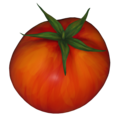Our website is made possible by displaying online advertisements to our visitors.
Please consider supporting us by disabling your ad blocker.
Berry
The word berry is used for many different kinds of small fruits that have many seeds and can be used as food. Some examples are raspberry, strawberry, sutberry, lingonberry and blueberry.
When botanists talk about berries, they mean a simple fruit produced from a single ovary. They sometimes call this true berry, to distinguish it from false berries. By that statement of how words are used, grapes or tomatoes are true berries.
The berry is the most common type of soft fruit in which the entire ovary wall gets to the right stage of development of the pericarp which can be taken as food. The flowers of these plants have an upper ovary with one or more carpels. The seeds are inside the soft body of the ovary.
Berries are small, sweet, bright colored fruits. Due to this, they are able to bring more animals towards them and spread their seeds.
Some fruits that are called berries in English are not true berries by the use of words above. These include raspberries, strawberry, sutberry, blackberries, cranberries, and boysenberries. Some true berries do not have berry in their name. These include tomatoes, bananas, eggplants, guavas, pomegranates and chillies. Pumpkins, cucumbers, melons, oranges and lemons are also berries that have slightly different structure and may be called by different names (pepo for pumpkins, cucumbers, and melons, or hesperidium for oranges and lemons).[1]
-
Four fruits that are true berries, shown larger than they are. Clockwise from right:
grapes, persimmon, red gooseberries, red currants (top) -
Several types of common "berries". None is a berry by botanical definition:
The blueberry is a false berry, blackberries are aggregate fruit, and strawberries are accessory fruit. -
A tomato, a type of berry.
- ↑ "Bananas are Berries. Raspberries are Not". Office for Science and Society. Retrieved 2021-07-22.
Previous Page Next Page





